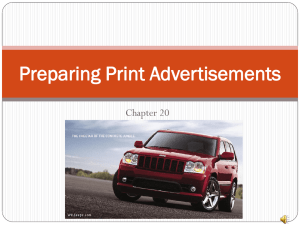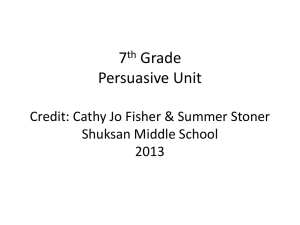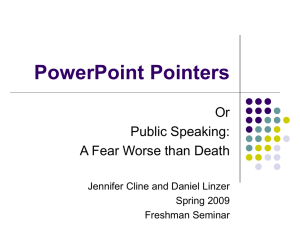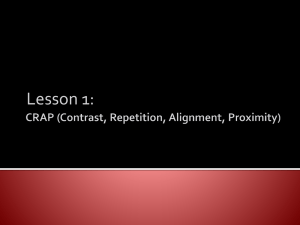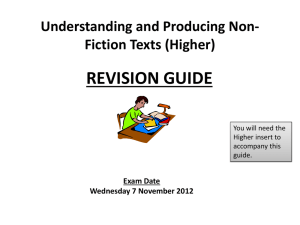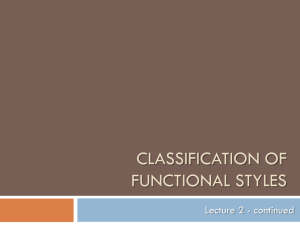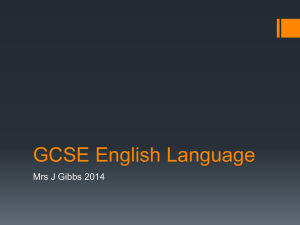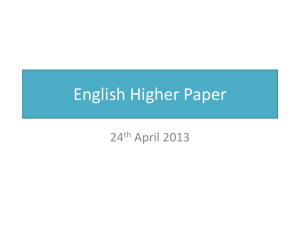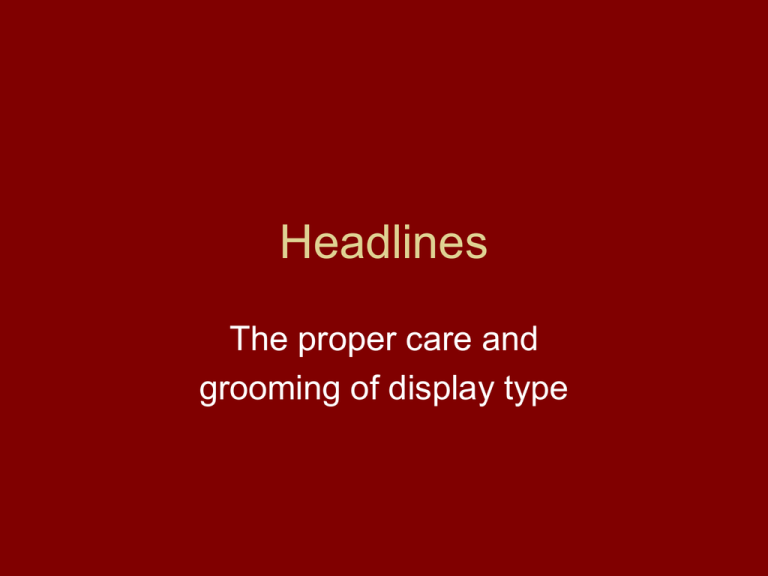
Headlines
The proper care and
grooming of display type
Headlines
A copy editor's prime directive is to correct and
refine copy, checking for accuracy, clarity,
conciseness, tone, consistency of style etc.
Recall the acronym “CCAFFE” (clear, concise,
accurate, fair, focused, efficient) from the Media
Writing class.
When you consider accuracy, clarity,
conciseness and tone, then you can see why
headlines are perhaps the most important -- and
often the most difficult -- portion of the editing
process.
Headlines: That first impression
A headline is the first thing a
reader notices -- so you
want to make a good
impression. Headlines -- the
large display type -- are a
major point of entry for
readers. You want a
headline that will effectively
introduce the reader to the
story.
Headlines
Headline writing is editing to the Nth degree.
After you run all the words in the story
through your mental condensation tube, the
headline is what is distilled out at the end.
Planning helps create a good headline, but
you can plan a headline weeks before and still
have problems. BUSH ELECTION NITE HED
Headlines: A history
Early American
newspapers had no
headlines. When one
story stopped, another
one started.
Publick Occurrences as it appeared in
Boston in 1690. It was four pages, and
was suppressed by the Massachusetts
governor after only one issue.
Headlines: A history
Headlines were gradually
introduced onto news pages in
the Revolutionary War period, and
by the mid-1800s the pendulum
had really swung. Label heads
(no verbs) in large type were often
followed by five or six or even 16
banks or decks. Those decks
might alternate between flush-left,
flush-right and centered styles.
This 1865 edition of the Philadelphia
Inquirer announces the assassination of
Lincoln.
Headlines: A history
By the late 1800s / early
1900s, newspapers tiptoe
into the modern era.
Headlines become wider,
bigger, bolder and many are
all caps. The advent of
photos affects headline
style.
The 1898 New York Journal announcing
the sinking of the USS Maine
Headlines: A history
One of the ugliest pages
ever seen (what’s the play
story?), but the headline
style is typical of the ’60s
and ’70s. Note the use of
alternating italic and
non-italic headlines.
A sports page from the 1966 Oregon
Journal
Functions of headlines
Attract the reader's attention (makes that good first
impression.) Sells the story. As a point of entry, it is
second to only the main photo/graphic element
Summarizes the story – that’s why a clear nut graph is
so important
Helps the reader index the contents of the page (can
scan page and choose what they really want to read.);
point sizes connote relative importance of story
Helps set the tone of the paper.
Provides typographic relief for the reader's eye. Serves
as a design element that provides contrast with point
size, typeface and type style (ital, bold etc.) Examples
Headline vocabulary (handout)
Point sizes: Used to connote the relative importance of a
story. Allows the reader to grade the news. The bigger the
point size, the bigger the story.
A 48 point head is twice the size of a 24 point head. A
48 point head (letters are three-quarters of an inch tall)
has greater size and weight than a 30 point or 24 point
head, implying that the story is of greater importance.
A 72 point head has one-inch tall letters (so an 18 point
is ¼ inch tall, a 24 point head is 1/3 inch tall, 36 point
head is ½ inch tall, etc).
What makes a good headline?
Like all other forms of communication, a headline is a pretty
subjective beast. It is certainly one area where the editor's
creativity (contests!) can shine, as long as accuracy, clarity
and tone are paid heed to.
Remember: The headline writer represents the reader.
Headlines are not complete sentences; instead, they are a
form of pidgin English; the textbook calls it a skeletonized
language. The articles a, an and the are cast aside for the
most part, and so is the verb is.
What makes a good headline?
1. Precise. Accurately reflects what the story is about. Being precise
means the head fits the tone of the story (but serious stories can
benefit from wordplay also).
Being precise also means you know the difference between a firstday headline and a second-day headline. (Example: Plant
explosion reported in Tuesday paper and there's a follow-up story
for Wednesday. Maybe the second-day headline focuses on the
blast investigation or condition of the victims - whatever the "new"
angle is.)
Being precise means moving the story forward. When a news event
occurs early in the news cycle, the headline writer avoids a news
peg that might be 12 hours old by the time the reader sees it.
Example: 4 Israelis are killed by a Palestinian suicide bomber, but
the Israelis might have retaliated – or talked about doing so -- later
in the evening. Go with the reaction / retaliation angle unless the
death toll climbs dramatically.
What makes a good headline?
2. Clear. Isn’t overly subtle or worse, unintelligible. You
don't say "huh?" after you read it. Don't use unfamiliar
names, phrases, abbreviations, headlinese etc. Anyone
know what the TCEQ is? “Martinez hits homer” – which
Martinez?
3. Passes ethical / legal smell tests. Is balanced and fair,
legally sound, tasteful in regard to subject matter. Don't
use phrases like "arrested for" or "indicted for" or
"charged for" -- only use the "for" word if someone is
convicted. "Arrested for" is considered libelous, and
lawsuits have been filed over that usage.
What makes a good headline?
4. Written with strong active verbs. Active voice is
preferred to passive voice, but passive still can be OK.
Gerunds (verbs ending with "ing") are OK but generally
not preferred. Headlines without verbs can sometimes
work, too; those are called label heads.
5. Fits the space requirement. You don’t worry about hed
space on the Internet, but you do in print and broadcast
graphics. Many of the best headlines ever written were
deep-sixed because they didn't fit. But AVOID PADDING
just to fill out a line. "U.S. Army medical doctor returns
home" is accurate -- but "Army doctor returns to Houston
from Iraq" has more information and is not redundant.
How to write a headline: Key steps
1. Judge the tone of
the story. A story can
be tragic, serious or
featurish / humorous.
Don't invite a clown to
a funeral -- unless it's
the clown's funeral.
Use appropriate tone.
If a story is funny, feel
free to take that next
flight to fancy.
After Manuel Noriega surrendered to
U.S. forces in 1990, the play head in
a London paper was Old Pineapple
Face Gives Up
How to write a headline: Key steps
2. Select the critical elements. Tip: Circle or highlight the
key words or phrases. If HISD is raising taxes in next year's
budget, then some of the obvious key words in the head
should be "HISD", "increases" "taxes" and "1998". Beware:
the best head might not always be found in the lede.
Then reduce the key words down to two -- a noun and a
verb. Tell me this song in two notes. Reducing the story to
a lowest common denominator of two words should give
you a good starting point.
Also, ask yourself why a story is on Page 1, at the top of
the Web site etc. – judge the significance. An example of
this ….
The Chronicle recently had a Page 1 story about a woman
who ordered her daughter and a friend to go rob a 75-yearold Pasadena man (allegedly). The pair killed the man in
the process of the robbery. Their loot? It was only $15.
Here was the headline that was turned in.
Mom orders daughter to rob Pasadena man
Accurate, yes. But is that why the story was on Page 1?
Partly, perhaps, but as senseless crimes go, this was pretty
far up there. This is what the head was changed to:
Pair kill Pasadena man during $15 robbery
It was the $15 angle that made the story rise to Page 1.
The mom ordering the daughter angle was put in a deck
headline.
How to write a headline: Key steps
Critical elements: It’s easy to start with the subject / verb / object form
(Police arrest man…). Then add the other key words as needed to
add clarity and substance. Some of the key elements:
a.
b.
c.
Subject – the main “who” in the
story, the protagonist, the central
character.
Verb – whatever the primary
action is. There may be more
than one, as in “Astros lose to
Reds, fall 5 games back in wildcard race.” Which clause is more
significant?
Object – the secondary
character/characters, perhaps
the recipient of the action. This is
where news judgment comes in.
d. Location – Localize whenever
possible. Proximity is a key factor
in newsworthiness. Location can
add clarity or serve as a memory
trigger as well.
e. Time element – helpful when
something happened years
before, as in a cold case. It may
be necessary for clarity.
f. Attribution – Sometimes who says
it adds weight to the subject. Use
attribution to avoid being
accusatory or defamatory.
How to write a headline: Key steps
3. Phrase those key words in the available space.
Check the head order and determine the count. The
count will be the same for each line of the head. Then
tinker with wording. "HISD increases taxes in 1998
budget" might not fit the head specification but "HISD
hikes taxes in ’98 budget" might fit and be just as
accurate.
Phrase help: Roget’s, thesaurus.com or dictionary.com
How to write a headline: Key steps
4. Feel free to be creative -- when appropriate! A play on words is one
of the headline writer's best friend. You might submit one hed that is
accurate but plain vanilla, but also submit other heads that are a bit more
daring. ‘Cheerleader Mom' trial reaches final phase is accurate but
'Cheerleader Mom' trial nears its last hurrah' has more pinache and
also tells the story.
How do you "kick it up a notch" as Emeril LaGasse would say?
Consider using puns (sparingly), -- synonyms and homonyms -- but
avoid cliches. This shoemaker has the time to try men's soles. Good,
strong quotes are handy devices, especially in slammers. Rhymes.
Alliteration. Repetition. Punctuation tricks. Steal from pop culture or
literature. Arnie / governor headlines like “Total Recall” or “Running
Man” or a play on “Terminator.” Sometimes people’s names or nicknames
can be a device.
Consult Roget's Thesaurus. Bartlett's Quotations. Dictionary of American
Slang. If you get stuck on a headline, walk away for a while. Free your
mind. Consult a friend or co-worker.
Headline helpers: Decks, kickers, subheds
These headlines are like the accompaniment to a lead singer. A good
accompanist adds zest to a song, but a bad one can destroy it. They
elaborate on the main headline, adding context or additional
information. They should not repeat information in the main head.
Perhaps they can serve as the actual explainer headline if the main
head is a label or an attempt at wordplay. Also, perhaps there is an
important second element in the story that cannot be captured in the
main head – a deck is a handy device for doing so.
Decks: Usually go below the main head, but sometimes “lead in” to the
main head.
Kickers: Usually a label head (no verb) above the headline
Subheds: Usually placed within the body of the story to introduce
particular sections or provide visual relief
Old decks vs. new decks
Other types of headlines
Rules for headlines
1. Spell everything right! (Home of the Whopper)
2. Avoid ending a line of a hed with a preposition (4 killed in /
I-45 pileup), conjunction, part of a verb (example: FBI vows to crack /
down on drug dealers) or modifiers
3. Don't editorialize -- except on editorial page. County OKs
lousy budget. However, if "lousy" had been in somebody's quote
(County OKs ‘lousy’ budget), that head would be OK.
4. Don't parrot the lede. Don't steal that great verb or adjective
by the writer -- come up with your own. If you want to make
enemies among reporters, just steal their thunder in your
headlines. Incidentally, I've often seen heads that were much
more interesting than the story.
5. Include a subject and a verb. Avoid or limit use of label heads
such as "Montrose murder," but who can’t appreciate the 9/11
headline that said simply Bastards!
Headline rules
6. Follow grammar rules, AP style. Watch out for noun-verb
disagreement
7. Watch out for double meaning. When intended, it can be great word
play. When unintentional, it can be embarrassing. (Preston Smith,
Ho Chi Minh)
8. Don't repeat words. Unless it’s for some special effect / creative
touch. The redundancies often occur in multi-headline treatments
(mainhed and deck).
Report: Smoking is bad
Nicotine linked to deaths of millions, report says
9. Present tense is preferred
10. Avoid headlinese -- those little crossword puzzle words like "mulls",
"Dems" and "solons".
Headline rules
11. Don't break compound nouns between lines.
Pilot tells Air
Force to buzz off
12. Avoid unfamiliar names and places. How many Smiths are there in the
vast, wide world of sports? Houston is bounded by several counties with
towns of the same name -- Brazoria, Liberty, Montgomery, Waller. So a
headline that said Brazoria official indicted could be confusing – is it a
county official or city official who is in trouble?
13. Hed punctuation -- You can use certain punctuation in place of words. A
colon can replace "says" or a comma can replace "and". Use single quotes
in heads. Numerals are preferred also.
Smith: Cowboys will win
UH, Rice set schedules
Plan criticized as ‘disastrous’
3 senators miss vote
3 11-story buildings destroyed
but avoid
14. Know first day heads vs. second day heads (folo stories)
15. Limit use of question heads.
Headline rules
Last, but definitely not least …
16. SPELL EVERYTHING RIGHT!!
Here are some heads that didn’t work so
well (handout) …
Headlines,schmeadlines (transparencies)
WHAT
NOT
TO
DO!!
Headline writing isn’t as simple as you may think
All the newss
thatss fit to
print?
It helps to get
the name of
your paper
right.
Right?
For pitcher Bartolo Colon, that’s gotta hurt!
For Tiger, that’s gotta … oh, never mind
Uhh…. Remember spellcheck?
Spelling errors are something to b-ware of.
Yes, spelling
can be … uh …
critical to your
credibility.
Spellcheck
would not have
saved you on
these two …
… but it would
on this one. FYI,
there’s no statue
of limitations on
spellcheck.
Sometimes you
have to have a
dirty mind … or
at least some
common
sense. The top
headline was
from a paper in
Culpepper, Va.
This was from
KU campus
newspaper.
Rock chalk,
Jayhawk!
Hail
to the
chief
Gives a whole new meaning to the phrase “talk to
the hand.”
Now here are some more …..
Why is
Chile so
persecuted?
A site for
sore eyes
no doubt
Remember Rule No. 1 …
Remember rule No. 1
Remember
rule No. 1
What can happen when you break a
compound noun between lines
Problems of a
scatological nature …
… or just headlines
that provide a
moving experience.
Web sites aren’t immune from
headline problems.
All I
can say
here is
…
huh?
There’s nothing like returning to Earth
after a long mission …
Ya think?
Where the rubber meets the road?
Read the story … then write the headline
You have to read
more than just the first
graf – or first word –
in a story. In this
case, yes, the
courthouse is in
Angleton, but the
health clinic is in
Alvin. Oopsy.
Remember
to read the
story …
sometimes it
can be a
matter of life
and death.
Where are those corners on a curve?
Here’s how to take two
cliches – turning the
corner and learning
curve – to create a
headline that will leave
’em scratching their
heads. Sadly, I actually
understand what the
hed writer was trying to
say here.
Setting the tone … but is it good taste?
Tabloids love to
be feisty … no
one can say this
isn’t a feisty
headline. It may
fit the tone of this
paper, but this
headline would not
run in the Chronicle.
Tone …. and taste
Headlines are supposed to
sell the story, but just what
are we selling here?
Actually, this is a review for
an off-Broadway production.
Sure, you can have some
latitude with the headline on
a feature/review – but can
you go this far?
Some ad headlines
These were eye-catching,
although one person misread
“bowls” as “bowels” … and I’m
not sure what “Wife Wanted”
has to do with sewing
machines.
Headline needs a comma, but it’s to the point
A good one to
end on
This was the headline on
a story about a Houston
neighborhood’s decision
to close off some streets
to limit cut-through traffic.
Obviously a play on the
Great Barrier reef.
Effective?
Extra credit exercise
Headline judgment:
What’s wrong -- or questionable /
problematic -- with these headlines? Each
has some violation of the headline rules.
Worth 2 points each for each one you nail
correctly.
More on heads in the next class.
More on headlines: Day 3
•
•
•
•
•
Practice headline writing for content
Head orders
Head count
Practice headline writing for content/space
Exercise for grade
Heads practice: Name that tune in 5 notes
Follow the instructions on the handout for
each of the three mini-stories. You will write
three headlines for each story, a separate headline
for each of the number of words requested. You
don’t have to worry about your headlines “fitting”
any space requirements. Just make sure
they accurately sum up the stories. You may be
asked to put your headlines on the board.
Head orders
Head orders have three parts:
• Width. The number of columns, or sticks of type,
wide a story is
• Point size. 72 point is 1 inch tall, etc.
• Depth. The number of lines
Thus, a 2-36-2 head order means the headline
should be two columns wide, use 36 point
type and be two lines deep.
Head orders
Count: An arbitrary value assigned to show how much
space a character takes up. Is determined by column
width, typeface (font) and point size. The count is the
same for each line of the headline!
For this class, since we don’t have a headfit program to
calculate width for us (as I do at the Chronicle), we’ll
have to use the old-fashioned “count out the words”
method for an imaginary typeface.
Head orders
Count Values
1. The number 1, most punctuation marks and lowercase f, l, i, t, j, r
(FLIT Jr.) are considered as ½ a count
2. The lowercase letters m and w are 1.5 counts.
3. Capped M and W are 2 counts. All other capped letters are 1.5
4. Everything else – numbers, letters and ? & $ % -- is one count
5. The spaces between words are a ½ count
(Note: We only cap the first word of the head and proper names)
Thus, the name Paul = 4 counts (1.5 + 1 + 1 + .5)
McGrath = 7.5 counts (2 + 1 + 1.5 + .5 + 1 + .5 + 1)
Head orders
So……
What is the “count” for this headline?
‘Beast of Baghdad’ threatens U.S.
Figuring head counts
‘Beast of Baghdad’ threatens U.S.
You should have come up with 28.5 counts
`Beast = 5.5 counts
of = 1.5
Baghdad’ = 8
threatens = 7.5
U.S. = 4
4 spaces = 2
Figuring head counts
Looking at our head count sheet – and given that
headlines are allowed to fall within a range of 3 counts
short to 2 counts long -- at what column widths and point
sizes does that `Beast of Baghdad’ head of 28.5
counts fit? The same headline fits at five point sizes:
6 columns wide at 60 point
5 columns wide at 48 point
4 columns wide at 36 point
3 columns wide at 30 point
2 columns wide at 18 point
Figuring head counts: A quick check
Want a quicker way of seeing how close you are on head
counts? Try this: assign a value of 1 to every letter, number
and “fat” punctuation marks (percent signs, question
marks). Keep spaces and “skinny” punctuation (commas,
periods, quote marks, colons and semicolons) at ½ count.
Now count out our ‘Beast of Baghdad’ threatens U.S.
headline. You should get 29 … pretty darned close to the
actual count of 28.5. (Did you remember to keep the
spaces at ½ count?) This quick check should save you
some time.
Figuring head counts
OK, so how does all of this work? Here is a typical head order: 2-36-2.
This means the headline goes over two columns (sticks) of type, each
line is 36 points (a half-inch) in size and is two lines deep. Look at the
head count sheet – column widths are across the top and point sizes
run down the side. To find the “count” for this head order, cross index
two columns with 36 points – to the right you should see a count of 15.
Point size
18
24
30
36
48
…
1
14.5
11
8.5
7
5.5
Columns
2
30
22.5
18
15
11.5
3
46
34
27
23.5
17.5
4
46
37
32
24
…. …. ….
Figuring head count
Because we have a range of 3 counts short to 2 long, each
line of this headline example must fit within a range of 12 to
17 counts. Maybe something like…
Houston police
capture suspect
= 12.5 counts
= 13 counts
The count is NOT a total for the entire headline; it
applies to each line that is requested in the head
order.
Writing heads: Practice
Write a 3-30-1 head (27 counts, range 24-29) for this story:
MIDLAND (AP) — A 3-month-old baby was left unattended in a
shopping cart for about an hour Sunday when her parents accidentally
left her behind, police said.
Shoppers noticed the abandoned baby at a Toys "R" Us store, Midland police
Sgt. Alfredo Grimaldo said.
"It was a misunderstanding among family members," Grimaldo said in
Monday editions of the Midland Reporter-Telegram. "One man took the
kids home and left the ladies to shop. But when he took the kids, he
didn't take the baby from the cart.“
The family members, who were traveling in different cars, didn't realize what
happened until they all got home and nobody had the baby, he said.
"We don't think it was really a child abandonment issue. It was just a
misunderstanding," Grimaldo said.
Headline practice: Possible heads
Shopping family overlooks baby
Midland family leaves tot behind
Midland 3-month-old left at store
Midland shoppers forget infant
Oops! Family leaves tot behind
Store’s holiday surprise: a baby
Ho-ho, oh no! Baby left at store
Headlines on the Web
On Web pages, headlines act as travel agents – a link – to the rest of
the story. Sometimes the headline is all you get on a home page; you
have to click once or twice to get to the rest of the story – unlike print,
where the story and headline are companions. Online headlines have
to get to the point and stay there; teaser / suspense headlines don’t
usually work as well. Sure, feel free to be creative if you think readers
are already familiar with the subject (ASTRONOMICAL: Astros win
NLCS). Other headline guidelines, especially accuracy, also apply.
The rule of thumb is to keep it short (fewer than 10 words) and to give
emphasis to the key or “buzz” words.
Example: Houston educator `thrilled and honored’
Teacher of the Year Dee Wallace gets award from a
former first lady
Changed to: Barbara Bush honors county’s Teacher of the Year
Headlines in magazines
Magazine headlines bear similarities to their Web and
newspaper cousins, but there are differences. Their main
calling in life is to attract attention, to outbark all the other
yapping dogs out there. Therefore, magazine heads are
often more tabloidish in nature – is it just me or is every
magazine story about sex, relationships, weight loss or
beauty tips? Magazine headlines often try to play off the
accompanying art, or are graphic elements themselves,
both on covers and inside. There is a greater use of label
heads and subheds; the subheds actually doing most of the
work on summarizing the story.
Headlines for PR, ads
Many news releases from PR agencies come with their
own headlines. That can be helpful -- but remember, it’s
their headline and the PR agency may weigh the news
differently than you. Here’s a Web site that lists key
(“action”) words for effective headlines on news releases:
http://blog.prleap.com/archives/25-action-words-for-writing-anewsworthy-headline/
Ads have headlines of sorts as well, or at least some
display type that stands out. Perhaps it’s the word SALE or
simply the merchant’s name will suffice. My favorite word in
ads is FREE!
Headline exercise
Your first editing grade … write headlines for these
10 stories. You will graded on headline content
and meeting the head order specifications.
To get you started … the Winnie headline calls for
a 2-36-1 main head (15 counts, range of 12-17)
and a 2-18-1 deck (30 counts, range of 27 to 32
counts). Since you can only get two or three words
in the main head, it’s OK to make it a label head. It
can be more creative; let the deck do the heavy
lifting.
Next class …
Editing ledes. Read the required chapter.
Headlines exercise will be due.


